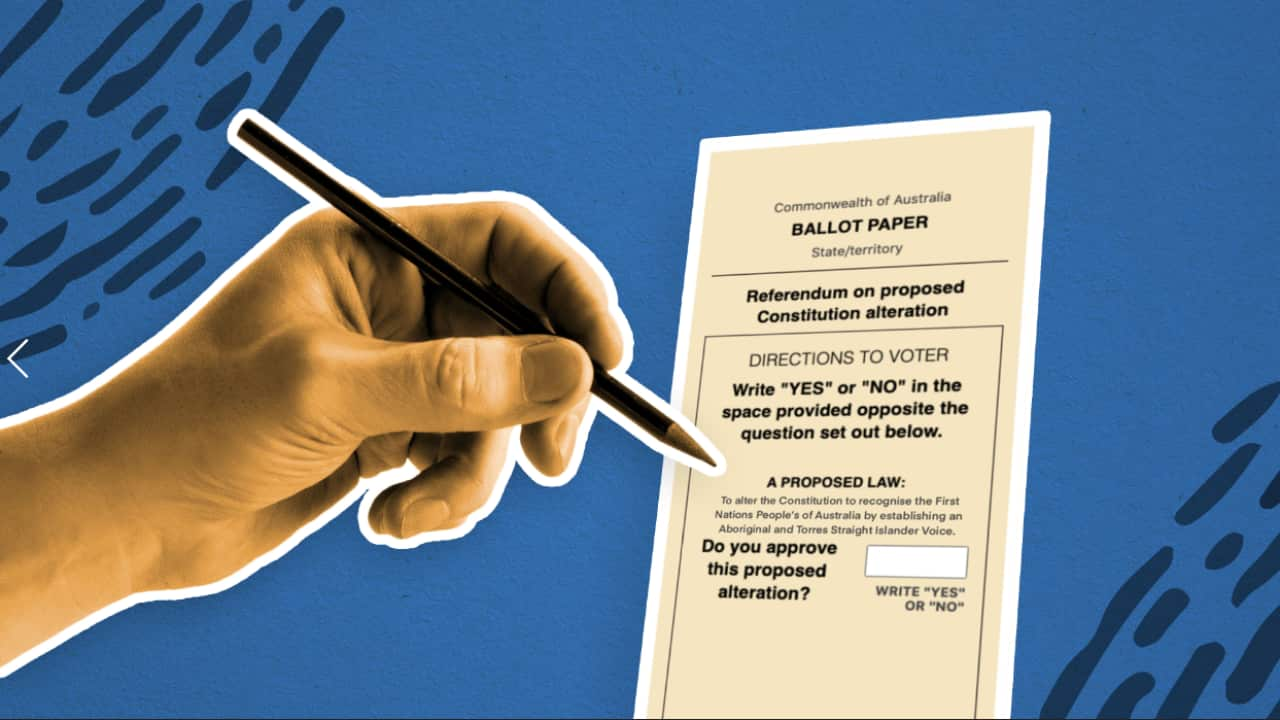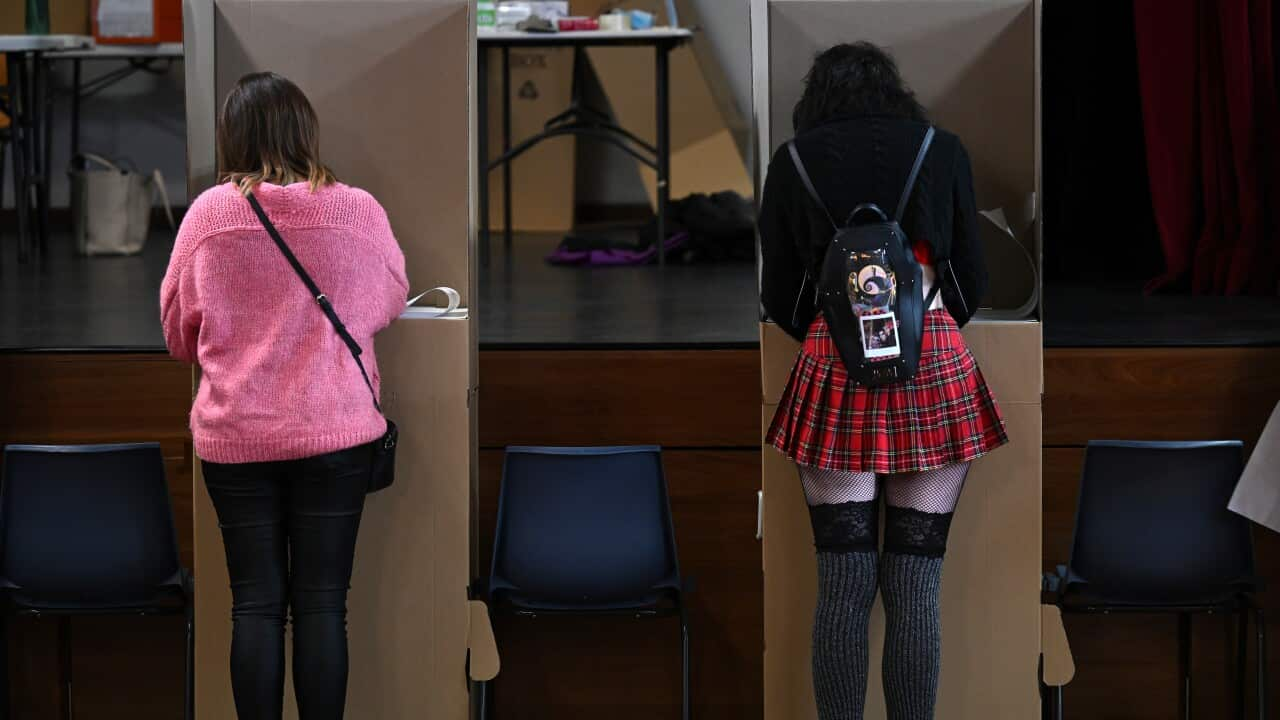Key Points
- Voters have received text messages and pamphlets suggesting they apply for a postal vote for the Voice referendum.
- Linking to a Liberal Party-authorised website, potential voters are asked to provide personal details.
- Postal voting for the referendum opened on Monday night and applications can be made directly through the AEC.
The Liberal Party is being accused of spamming voters, over text messages being sent out in the lead-up to the upcoming Indigenous Voice to Parliament referendum.
Some Australians posted on social media on Tuesday night about receiving an SMS urging them to vote No, and also to apply to make a postal vote.
The text messages, like pamphlets distributed in recent days, included a link to a website authorised by the Liberal Party.
The Australian Electoral Commission is the independent authority responsible for running the referendum.
So why were people receiving text messages from the Opposition's Indigenous Australians spokesperson Jacinta Nampijinpa Price and the WA Liberal party about postal voting applications?
Third-party postal voting applications
Postal voting allows people who are unable to attend a polling place in person to take part in the referendum.
Australian Electoral Commission spokesperson Evan Ekin-Smyth told SBS News about 14 per cent of votes in the 2022 federal election were cast this way.
About half of all votes were done in person on polling day, with the remainder submitted in the two weeks leading up to the election at early polling centres.
"We had something like 30,000 in the first three hours, so there's tens of thousands of postal vote applications that have already been lodged," Ekin-Smyth said.
The AEC has a , where people can find unbiased information about voting and apply for postal voting.
The text and the Liberal Party authorised website
The text messages sent on behalf of the Liberals and Price labelled the Voice proposal as "risky and divisive, with no details" and suggested people should vote No.
The Labor government and Yes campaign have countered these claims in the past, pointing out that the Voice was recommended after a years-long engagement process with Indigenous communities around Australia.
While the federal parliament would put together the specific legislation determining what the Voice to Parliament would look like following a successful Yes vote, information is already available about its broad function.
The Voice would be a body advising the government on issues that particularly impact Indigenous Australians. Yes campaigners have , such as poverty, incarceration, child removal, and poor health and educational outcomes.
Members would have fixed-term dates to "ensure accountability". Its membership would be gender-balanced and include youth members, draw on representatives from all states and territories and include representatives from specific remote communities.
According to the Yes side's proposed constitutional amendment, the parliament would retain power over the "composition, functions, powers and procedures" of the Voice.
The text messages sent on behalf of the Liberals and Price ended with the call to action "To apply for a postal vote", followed by a link.
The same link was provided on a pamphlet sent out jointly by Price, who is a Country Liberal Party senator, and Kevin Hogan, a Nationals MP, which lists "10 reasons to say No" to the Voice.

Source: Supplied
It lists some of the reasons a person may seek to vote via post and has an 'apply' button beneath them.
Upon clicking on it, people are asked to provide details including their name, address, email address and phone number.
When being asked for the last of these details, people are informed by submitting one's details "you will be providing this information to the Liberal Party of Australia and the Nationals, who will contact you regarding the referendum". Upon giving that information, the page redirects to the AEC's postal vote application.
Are political parties allowed to text us?
Phone messages being sent by political parties was a topic of discussion during the 2022 election, when text messages were .
The Australian Communications and Media Authority (ACMA) confirmed to SBS News that, as with last year, the situation remains that messages from registered political parties do not have to comply with the Spam Act.
ACMA advised complaints relating to such messages should be directed to the authoriser.
Are third party applications legal?
Political parties sending physical postal vote applications to people who request them or providing a link to the AEC's online application form is not illegal.
However, Electoral Commissioner Tom Rogers last year described the practice as "potentially misleading" and the "number one complaint" received in regard to the federal election.
The AEC refers to it as sending "third-party postal vote applications".
The Liberals are not the only party who have used websites to get voters to register for postal votes through them. For last year's federal election, Labor set up howtovote.org.au for that purpose. The website is no longer active.
"This is an application with no ballot papers involved," Ekin-Smyth said.
"What we're talking about is an application only. If a political party receives a postal vote application, they're obligated to send it swiftly back to the AEC. We then process everything.
"The AEC handles your ballot papers for postal votes.
"Ballot papers are sent from the AEC directly to a postal voter, it comes directly back to the AEC."
Dealing directly with the AEC
Applying for a postal vote directly through the AEC’s website removes the unnecessary middleman, so people who request a physical ballot paper in the mail would likely receive it quicker.
Your information will also be afforded a level of protection.
"If you're at all concerned about your privacy because there is personal details involved in applying for a postal vote, the AEC has to operate under the Privacy Act, political parties do not, so our advice, once again, is to come to the AEC directly," Ekin-Smyth said.
Independent MP for Curtin Kate Chaney has including measures to "stop postal voting applications from being used for data harvesting and misleading voters."
Stay informed on the 2023 Indigenous Voice to Parliament referendum from across the SBS Network, including First Nations perspectives through NITV.
Visit the to access articles, videos and podcasts in over 60 languages, or stream the latest news and analysis, docos and entertainment for free, at the .












